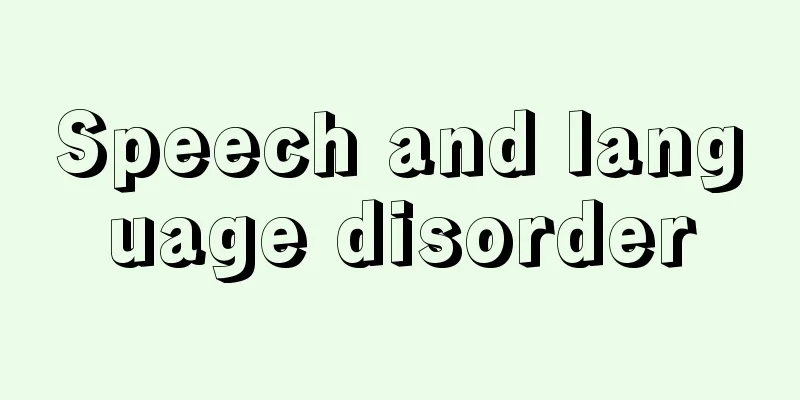Speech and language disorder

|
Disorders in the transmission and reception of information through language. Language disorders occur for a variety of reasons and can be found in all age groups, from infants to the elderly. [Language development disorder] A state in which the development of language behavior is far behind that of other children of the same age is called developmental language disorder or delayed language development, and is the most common language disorder in children. There are various causes of language development disorder, but the most common is delayed language development due to mental retardation, and the delay in the development of symbolic functions is particularly noticeable. The cause is unknown, but genetic factors are thought to be involved. A state in which language development is significantly delayed despite the absence of mental retardation, hearing loss, interpersonal disorder, brain damage, environmental problems, etc. and the cause cannot be identified is called specific developmental language disorder. Language development is also delayed due to pervasive developmental disorder. This is because pervasive developmental disorder, especially autism, is hindered by conditions such as delayed development of the ability to maintain relationships with others, qualitative abnormalities in communication (echoing and unique expressions), limited interests and activities (fixation on marks and numbers), and stereotyped and repetitive behavior. Although we are still far from understanding the causes of pervasive developmental disorders, it is noteworthy that research results have been reported that suggest the presence of subtle brain damage. In addition, language development is also delayed in cases of learning disorders (LD), which are conditions that make it difficult to learn language-related areas, i.e., "reading, writing, comprehension, and calculation," but the cause is also unknown. Furthermore, language development is also delayed in cases of childhood aphasia caused by brain damage due to traffic accidents or injuries. [Articulation disorder] The second most common type after delayed speech development is articulation disorder, also known as pronunciation disorder. Articulation disorders are broadly divided into three types: functional, organic, and motor. Functional articulation disorders are a condition in which articulation errors are fixed despite the absence of abnormalities in the form and function of the speech organs or central motor disorders, and no cause can be found. Organic articulation disorders are articulation disorders caused by abnormalities in the form and function of the speech organs, and a typical example is cleft lip and palate. Cleft lip and palate are conditions in which the development of the lips and palate is not complete early in the fetal stage for some reason (for example, the effects of medication taken by the mother after pregnancy). If a baby is born in this condition, various problems will arise, but the most important one is abnormal speech. Abnormal pronunciation due to tension in the throat, characteristic pronunciation errors, breathing out from the nose, and nasal voice are noticeable, and the overall speech will be very unclear. Motor speech disorders are mainly caused by cerebral palsy in children. In such cases, speech disorders are often accompanied in addition to speech disorders. Voice disorder refers to a state in which a child's voice is too high or too low, lacks intonation, is too loud or too quiet, or has a changed quality (hoarseness, raspy voice, etc.) compared to children of the same age and sex. In children, the main cause is overuse of the voice. Stuttering, a speech fluency disorder (abnormal repetition, prolongation, interruption, repetition of sounds or syllables, etc.), is a speech disorder that has been known since ancient times in human history, but the cause is still unclear. [Language disorders in adults] Aphasia is a typical example. Aphasia is a condition in which the operation of previously acquired language codes (expression and comprehension of spoken and written language) is impaired due to damage to a specific area of the cerebrum. The main causes of aphasia are cerebral hemorrhage and cerebral infarction, which account for 90% of cases. Brain tumors and brain trauma (due to traffic accidents, etc.) can also cause aphasia. The incidence of aphasia after cerebrovascular disorders has been reported to be 15-20%. The main symptoms of aphasia are speaking disorders (word finding difficulties, paraphasias, pronunciation disorders, grammar disorders, jargon), listening and comprehension disorders (auditory grasp/comprehension disorders), writing disorders (agraphia, paragraphia), reading disorders (dyslexia), and calculation disorders (acalculia). Based on the characteristics of these symptoms, aphasia is classified into several types. The main types of aphasia are expressive aphasia (Broca's aphasia), in which spoken language is understood but difficult to produce, receptive aphasia (Wernicke's aphasia), in which speech fluency is preserved but language comprehension is difficult, anominomic aphasia (simple aphasia, amnesic aphasia), in which the patient has difficulty naming objects or ideas, and total aphasia, in which all language functions are affected. The second most common language disorder in adults after aphasia is dysarthria. Dysarthria is a speech disorder caused by damage to the nervous and muscular systems that control the movement of the speech and vocal organs. This disorder is also called paralytic dysarthria, motor dysarthria, or motor dysarthria. Dysarthria can occur for a variety of reasons, including cerebrovascular disease, brain tumors, brain trauma, degenerative brain diseases (Parkinson's disease, chorea, spinocerebellar degeneration, amyotrophic lateral sclerosis, etc.), demyelinating brain diseases (multiple sclerosis, etc.), and metabolic disorders of the brain (Wilson's disease, alcoholic cerebellar degeneration, etc.). In addition to these disorders, adults also suffer from stuttering (the majority of cases occur in childhood and persist into adulthood), organic speech disorders, and dysphonia. The main organic speech disorder in adults is that caused by removal of tongue cancer. Depending on the state of the cancer, part, half, or the whole tongue, or the whole tongue and floor of the mouth, may be removed, and the state of dysphonia varies depending on the extent of the resection. Adult dysphonia is caused by diseases of the vocal cords, abnormalities in hormone secretion, psychological causes, and overuse of the voice. If a tumor (laryngeal cancer) develops near the larynx, complete removal of the vocal cords will result in complete loss of voice. [Treatment of Speech Disorders] We work to improve the functional impairments of children and adults with speech disorders, improve their communication skills, and promote their participation in society. Methods that work on the speech disorder itself to correct or reduce the disorder include breathing training, voice training, articulation training, training to increase vocabulary and improve grammatical disorders, fluency promotion training (training to promote fluency in speech and reduce disfluency due to stuttering), and speech listening training. On the other hand, methods to improve or supplement communication skills include speech training (training in speaking style, such as speaking speed and intonation) and pragmatic communication training (training to use appropriate communication means in various communication situations and circumstances). We also work to encourage the use of communication aids (letter boards such as the 50-sound chart), the use of alternative organs (esophageal speech, compensatory articulation, etc.), and the use of assistive devices and equipment (for example, artificial larynxes and hearing aids). These are approaches called augmentative and alternative communication (AAC). Methods of adjusting the environment to promote social participation include approaches to families of people with disabilities (such as guidance on how to interact with them, training at home, and promoting acceptance of disabilities), approaches to relevant parties at daycare centers, kindergartens, schools, etc., approaches to the workplace, and approaches to the community (such as support for group activities for people with disabilities, and the establishment and operation of shared workshops). →Learning disabilities →Language development →Pervasive developmental disorders →Aphasia →Intellectual disabilities [Ito Motonobu] Latest Sources Psychology Encyclopedia Latest Psychology Encyclopedia About Information |
|
言語による情報伝達と受容の障害。言語障害はさまざまな原因で発生し,しかも,乳幼児から老人に至るすべての年齢層に見られる。 【言語発達の障害】 言語行動の発達が同年齢の他の子どもに比べてかけ離れて遅れている状態を言語発達障害developmental language disorderあるいは言語発達遅滞delayed languageといい,小児の言語障害の中で最も多く見られる。言語発達障害の原因はさまざまであるが,最も多いものは,精神発達遅滞に伴う言語発達の遅れであり,とくに象徴機能の発達の遅れが顕著である。原因は不明であるが,遺伝的要因が考えられる。精神遅滞,難聴,対人関係障害,脳損傷,環境上の問題などがなく,原因を特定できないにもかかわらず,言語発達が突出して遅れている状態を特異的言語発達障害specific developmental language disorderという。また,広汎性発達障害pervasive developmental disorderによっても言語発達が遅れる。広汎性発達障害とくに自閉症の特徴である,人との関係を維持する能力の発達の遅れ,コミュニケーションの質的異常(オウム返しや独特な言い回し),興味や活動の制限(マークや数字に固執する),常同的で反復的な行動といった状態がことばの発達を阻害するためである。広汎性発達障害の原因解明にはいまだほど遠いが,微細な脳損傷の存在を示唆する研究結果が報告されていることは,注目に値する。このほかに,言語が関係する領域,すなわち「読み,書き,理解,計算」の学習が困難な状態としての学習障害learning disorder(LD)の場合もことばの発達が遅れるが,これも原因不明である。さらに,交通事故やケガなどで脳に損傷を受けて,小児失語症になった場合もことばの発達が遅れる。 【構音障害articulation disorder】 言語発達の遅れに次いで多いのは構音障害で,発音障害ともいわれる。構音障害は,大きく,機能性,器質性,運動性の3種類に分かれる。機能性構音障害とは,発声発語器官の形態と機能の異常や中枢性の運動障害がなく,原因が認められないにもかかわらず,構音の誤りが固定化している状態である。器質性構音障害とは,発声発語器官の形態や機能の異常による構音障害で,代表的なものは,唇裂・口蓋裂によるものである。唇裂・口蓋裂とは,胎生早期になんらかの理由(たとえば,母親が妊娠後に服用した薬の影響)で,唇や口蓋の発育が完成しない状態をいう。このような状態で生まれてくると,さまざまな問題が生じるが,いちばん重要なのは話しことばの異常である。喉に力が入った異常な発音や特有の発音の誤り,鼻からの息漏れ,鼻声などが目立ち,全体的に非常に不明瞭なことばになる。運動性構音障害は,子どもの場合主として脳性麻痺によるものである。この場合は,構音障害に加えて発声障害を伴うことが多い。発声障害(音声障害)voice disorderとは,同年齢,同性の子どもと比べて声が高すぎたり,低すぎたり,抑揚が乏しかったり,大きすぎたり,小さすぎたり,声の質が変わっていたりする(しわがれ声,かすれ声など)状態を指す。子どもの場合は,声の乱用が主な原因である。ことばの流ちょう性の障害(音・音節の異常な繰り返し・引き伸ばし,とぎれ,言い直しなど)である吃音stuttering(いわゆる,どもり)は,人類の歴史上古くから知られていることばの障害であるが,いまだに,原因が明らかではない。 【成人の言語障害】 代表的なものは,失語症aphasiaである。失語症とは,大脳の特定領域の損傷により,既得の言語符号の操作(音声・文字言語の表出と理解)機能が障害された状態である。失語症をもたらす主な原因は,脳出血と脳梗塞で,失語症の原因の90%を占める。また,脳腫瘍や脳外傷(交通事故などによる)も失語症を引き起こす。脳血管障害後の失語症の出現率は,15~20%と報告されている。失語症の主な症状は,話すことの障害(喚語困難,錯語,発音の障害,文法の障害,ジャーゴンjargon),聞いて理解することの障害(聴覚的把持/理解障害),書くことの障害(失書,錯書),読むことの障害(失読),計算障害(失計算)である。これらの症状の特徴から,複数のタイプに分類される。主な失語症のタイプは,話しことばの理解は保たれているが発語に困難のある運動失語expressive aphasia(ブローカ失語),逆に発話の流ちょうさは保たれているが言語理解に困難のある感覚失語receptive aphasia(ウェルニッケ失語),ものや観念の名前を言い表わすのが困難な失名詞失語anomia(単純失語,健忘失語),すべての言語機能に困難を起こす全失語total aphasiaである。 失語症に次ぐ成人の主な言語障害は,ディスアスリアdysarthriaである。ディスアスリアは,発声・発語器官の運動を支配する神経・筋系の損傷による構音や発声の障害である。この障害は,麻痺性構音障害,運動障害性構音障害,運動性構音障害などとよばれることもある。ディスアスリアは,脳血管障害,脳腫瘍,脳外傷,脳の変性疾患(パーキンソン病,舞踏病,脊髄小脳変性症,筋萎縮性側索硬化症など),脳の脱髄疾患(多発性硬化症など),脳の代謝異常(ウィルソン病,アルコール性小脳変性症など)といったさまざまな原因で起こる。 これらの障害のほかに,吃音(大多数が,子どもの時に生じておとなになっても治っていない場合である),器質性構音障害,および発声障害が成人でも生じる。成人の主な器質性構音障害は,舌癌を摘出したために起こるものである。癌の状態によって,舌の一部,半分,全部あるいは,舌全部と口腔底を切除する場合があり,切除範囲によって構音障害の状態は異なる。成人の発声障害は,声帯の病気,ホルモン分泌の異常,精神的な原因,声の乱用などによって起こる。喉頭付近に腫瘍(喉頭癌)ができた場合,声帯を全摘すると声をまったく出せなくなる。 【言語障害の治療】 言語障害をもつ子どもや成人の機能障害を改善し,コミュニケーション能力を高め,社会参加を促進する働きかけを行なう。言語障害そのものに働きかけて,障害を矯正したり軽減したりする方法には,呼吸訓練,発声訓練,構音訓練,語彙の増加や文法障害の改善訓練,流ちょう性促進訓練(発話の流ちょう性を促進し,吃音による非流ちょう性を軽減する訓練),ことばの聞き取り訓練などが含まれる。一方,コミュニケーション能力を高めたり補ったりする方法には,発話訓練(話す速度や抑揚のつけ方などの話し方の訓練)や実用コミュニケーション訓練(さまざまなコミュニケーション場面・状況下で,適切なコミュニケーション手段を用いる訓練)などがある。また,コミュニケーション補助手段(50音表などの文字盤)の利用,代替器官の活用(食道発声,代償構音など),補助器具・機器(たとえば,人工喉頭,補聴器)の使用などを促すための働きかけを行なう。これらは,拡大・代替コミュニケーションaugmentative and alternative communication(AAC)とよばれるアプローチである。社会参加を促進するための環境調整の方法には,障害をもつ人の家族への働きかけ(接し方の指導,家庭での訓練,障害受容の促進など),保育園,幼稚園,学校などの関係者への働きかけ,職場への働きかけ,地域への働きかけ(たとえば,障害者のグループ活動の支援,共同作業所の設置・運営)などが含まれる。 →学習障害 →言語発達 →広汎性発達障害 →失語症 →知的障害 〔伊藤 元信〕 出典 最新 心理学事典最新 心理学事典について 情報 |
<<: Language processor - Gengoshorikei (English spelling) language processor
>>: Linguistic genealogy - Gengokeitoron (English spelling) Linguistic genealogy
Recommend
Gambler - Bakuto
People who make a living through gambling. Also k...
Shingi
This refers to the code of conduct for the monast...
reeve
…A bird of the family Scolopacidae. The male is c...
Sabellianism
…a man who, along with Arius, advocated heresy (S...
Pawpaw - Popo (English spelling) Pawpaw
A deciduous tall tree of the Annonaceae family, pa...
Kasuke Incident - Kasuke Incident
This was a peasant uprising that broke out in Mats...
Kitashu painting
This term comes from the debate on the north and ...
Samotlor oil field - Samotlor Yuden (English spelling)
Discovered in Western Siberia in 1965, it is the l...
Resistance thermometer
A thermometer that utilizes the property that the...
Ameen, HA - Ameen
...However, the military, Khalqi and Parcham fact...
Streptomyces verticillus
...An antitumor antibiotic obtained from the cult...
Cow water system - Gyusuisei
… Water regulating systems, known in Japan as miz...
Andhra tribe - Andhra tribe
…It can also refer to art related to the Satavaha...
Uchima Palace
<br /> The remains of a mansion in Kadekari,...
Ecole des Ponts et Chausées (English: Ecole des Ponts et Chausées)
...This section provides a historical overview of...




![Inabe [town] - Inabe](/upload/images/67caefddba10c.webp)



![Sierra Nevada [mountain range] (English spelling)](/upload/images/67cbb9f7b0881.webp)
